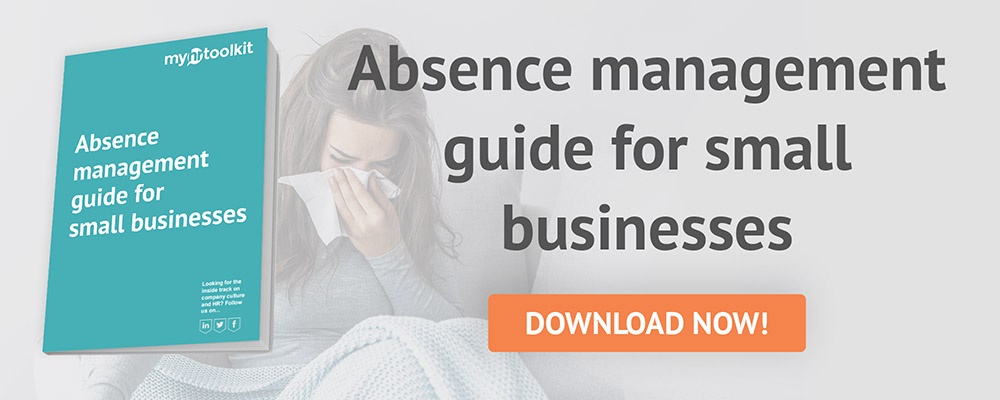Ill health costs the British economy approximately £77.5 billion every year. That’s a huge productivity loss that works out to an average of £500 per employee per year.
Why is this figure so high - and what can employers do to address lost productivity related to employee sickness absence? Here we’ll examine some of the key areas that leaders can focus on to reduce sickness issues and boost productivity.
The modern landscape of ill health at work

Productivity loss isn’t only due to sickness absence from work; presenteeism (working while ill) is having a huge impact on productivity and the UK economy too. According to Vitality’s 2019 Britain’s Healthiest Workplace report, presenteeism was the most significant driver of productivity loss for those surveyed, with 55 minutes of every lost productive hour due to presenteeism.
Related article: Remote workers and e-presenteeism: how to manage it
Leaveism (employees using other forms of leave as sick leave) is another issue having an impact upon the wellbeing of staff and the productivity of businesses. So, it’s not just absence levels that indicate how healthy and productive a workforce is. Paying attention to staff who turn up to work ill and take annual leave as sick leave is important too.
How to address lost productivity due to employee sickness

Sometimes sickness and absence are unavoidable. However, there are strategies businesses can use to help promote staff health and wellbeing for better productivity. Here are five key ways organisations can address productivity loss due to absence and ill health:
1. Have watertight absence processes
It’s difficult to judge the impact of employee sickness absence upon business productivity without a consistent process for recording and addressing absence. From communicating your policies clearly to responding to absences in a timely manner, having a fair and empathetic approach to absence management can make all the difference.
Absence management software is highly helpful when it comes to recording and analysing absence. You can create reports on sickness absence and set trigger points to alert managers when particular conditions are met or actions required. By automating some elements of absence management, you can focus on the more important things.
Learn how to manage absence effectively and boost business productivity with absence management software.
2. Address the stress
There’s no avoiding it: stress is one of the biggest causes of ill health for UK workplaces. The Vitality 2019 survey found that 35.1% of employees reported having felt unwell due to work-related stress. The CIPD found that stress is also one of the biggest causes of long-term absence; 37% of organisations who responded to their survey reported an increase in stress-related absence.
Furthermore, work burnout due to workplace stress will be recognised as a medical condition by the World Health Organisation (WHO) from 2020 onward. Now is the time to introduce stress-busting strategies into the workplace to help reduce the effects that chronic stress can have on employee health and productivity. We’ve written a guide on how to reduce stress at work for better productivity to help you set strategies in motion.
3. Consider recruiting more staff
Are employees’ workloads causing too much stress or even burnout? Statistically, this is quite likely; workload is one of the most common reasons for work-related stress according to the Health and Safety Executive. One way to ensure business growth and better employee wellbeing within the organisation is to continuously review your hiring practices.
Not sure if it’s time for a new hire? Consider the costs of recruiting a new employee against the productivity they can bring to the business in terms of their skills and workload capacity. New hires can also help current staff who are feeling overworked, reducing the risks of ill health or a high turnover rate.
4. Curb potential absenteeism
Though it’s not nearly as common as presenteeism as a cause of productivity loss, absenteeism (sick leave without good reason) is still a concern for employers. Bear in mind that, in most cases, absences are genuine; employees shouldn’t be treated as ‘guilty before proven innocent’ when it comes to sick leave. This could have a negative impact upon an employee’s levels of trust and satisfaction at work – and cause them undue stress, increasing the likelihood of ill health or stress-related absence.
Read our guide on how to address absenteeism with an employee to find out more about how to approach the situation.
5. Prioritise flexible working
Flexible working has been shown to reduce work-related stress and long-term absence rates, according to the CIPD. So, if flexible working practices can be an option for your business, they’re well worth exploring. It has already proven a popular strategy for tackling absence within SMEs. 35% of SMEs actively use flexible working strategies to combat absence, as reported by Personnel Today. Other popular methods include return to work interviews (17%), stress counselling (14%), and disciplinaries (14%).
HR expert Gemma Dale has written an in-depth flexible working guide for employers if this is something you’re interested in offering to employees or want to promote more effectively.
Key takeaways on absence and productivity

- Make sure to monitor presenteeism and leaveism as well as sickness absence when it comes to measuring the impact of ill health on productivity.
- Have watertight and consistent absence processes in place to help record and address employee sickness absences.
- Address levels of work-related stress in the workforce, as this is a huge drain on productivity due to ill health and stress-related absences.
- Consider hiring more staff when it makes financial sense for the business. This can help reduce absence and maintain productivity long-term.
- Address potential absenteeism carefully and sensitively; most absences are genuine.
- Prioritise flexible working initiatives to help reduce stress and long-term absence.
Read more from our blog
How to improve sickness absence in the workplace

Written by Camille Brouard
Camille is a Senior Marketing Executive for myhrtoolkit who writes on topics including HR technology, workplace culture, leave management, diversity, and mental health at work.


 Holiday Planner
Holiday Planner Absence Management
Absence Management Performance Management
Performance Management Staff Management
Staff Management Document Management
Document Management Reporting
Reporting Health and Safety Management
Health and Safety Management Task Management
Task Management Security Centre
Security Centre Self Service
Self Service Mobile
Mobile




